What is a food pyramid and its basic principles
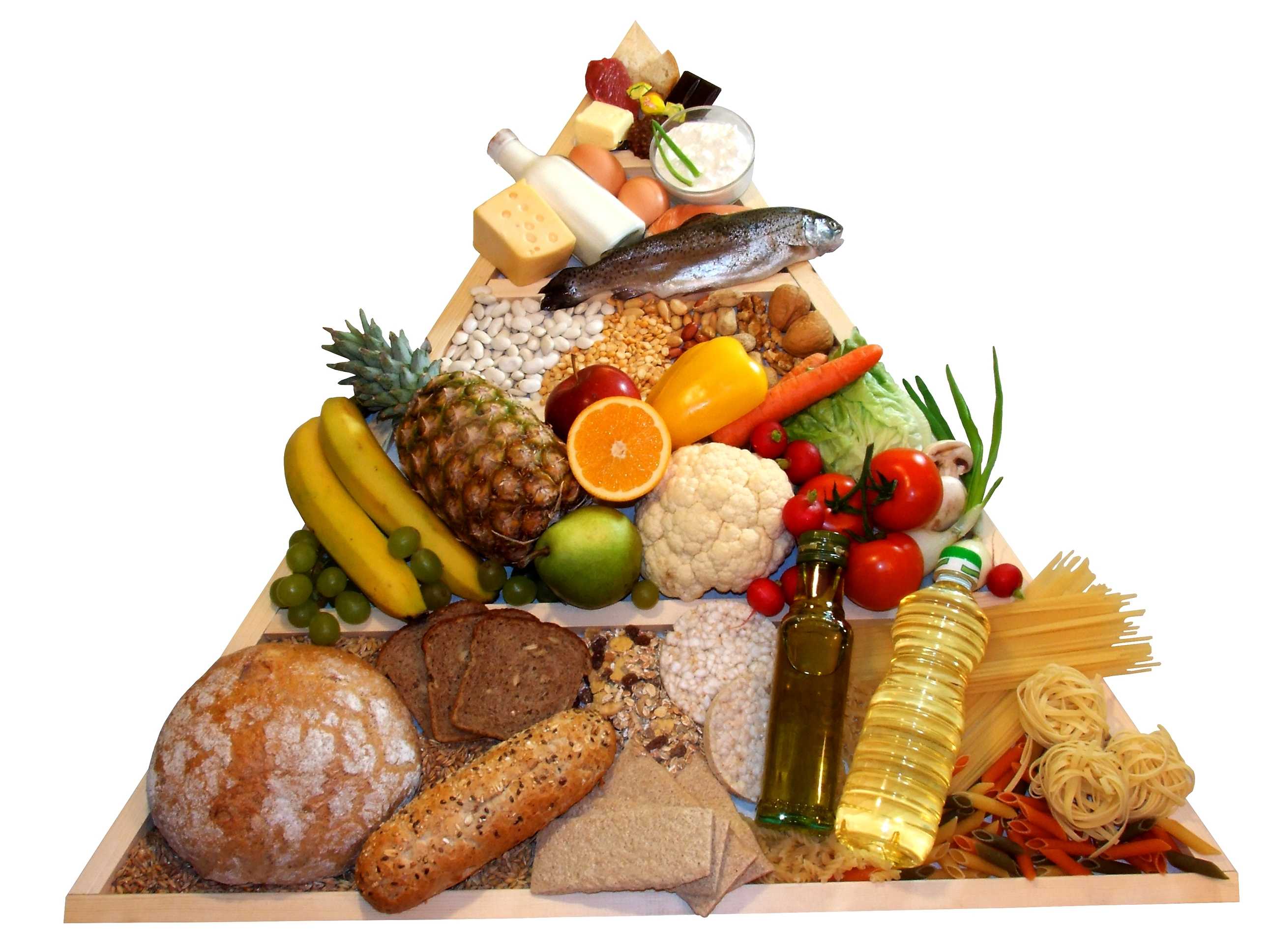
food pyramid
Coleman 2017 devoted sufficient time to their meals. And this is not accidental: it is the right nutrition, coupled with intensive training, responsible for building muscle mass. Focusing on the value of a product, Lou Ferrigno include them in their diet. An invaluable help in building a food scheme is the food pyramid, which is a graphical set of rules for a balanced diet.
What is a food pyramid?
Before going directly to the concept of the food pyramid, it should be said that all products can be divided into several groups according to their physical state:
- solid;
- loose;
- liquid.
Gradation can also be made based on the frequency of consumption of certain products. For example, we not only eat one of them every day, but also do not imagine life without them. Others we consume from time to time, and we try to avoid others in view of their uselessness and harmfulness.
The food pyramid is a schematic representation of the principles of healthy eating. It is developed by dieticians and, like an ordinary pyramid, has its base and top. Adhering to the rules of healthy eating, a person makes for himself a food basket, moving from the bottom of the pyramid to its top.
The basis of the food pyramid is products appearing on our table daily, and the top is food products, which should be avoided. The pyramid of healthy nutrition is indispensable for a person actively engaged in sports. Building your diet according to its principles, you can achieve some significant results. And for this you need to know the “body” of the pyramid, i.e. those groups of products from which it consists, and its basic principle: daily exercise, the intake of sufficient amounts of fluid and control of type of bodybuilders. Read the article about pre-training complexes.
Schematically, the food pyramid of correct nutrition is as follows:
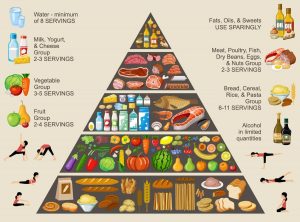
Those. in the basis we see the main principle, and then the groups of products that can be conditionally divided into three types:
- proteins;
- fats;
- carbohydrates.
At the same time, the share of the latter should account for a maximum percentage of 50-60%. Proteins in the diet should be no more than 25-30%, and fats – 10-15%. It is this proportion that is optimal not only for muscle growth, but also for maintaining excellent health.
Steps of food pyramid
The pyramid of a healthy person’s nutrition consists of four stages:
- base;
- second stage;
- the third step;
- top.
We will analyze each of them separately.
Base
The base of the pyramid consists of three groups of foods that must be found in the diet, if not daily, then as often as possible.
| Group | Products | | Why is it necessary? |
| Vegetables and fruits | All fruits and vegetables | Contain a lot of fiber, slowing down the absorption of food, vegetables contribute to better digestion of protein. |
| Vegetable unsaturated fats | Corn, sunflower, rapeseed, linseed, olive oil | Promote rapid muscular recovery after intensive training, reduce cholesterol. |
| Whole-grain foods (complex carbohydrates) | Wholemeal bread, pasta from durum wheat, cereals, unpolished rice | Provide the body with nutrients, contain a minimum of sugar |

The second stage
The next step is represented by protein-containing products, which can be of plant and animal origin.
| Kind of proteins | Products | | Why is it necessary? |
| Vegetable | Seeds, nuts, beans, lentils, beans, chickpeas, mushrooms | Contains protein and a large amount of fiber, which has a beneficial effect on the work of the intestines and is used in many weight loss programs. |
| Animals | Meat, fish, poultry, seafood, eggs, chicken | Contains all the essential amino acids . |
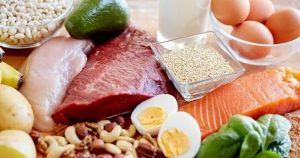
Third stage
It includes milk and its containing products, which can be kefir, cottage cheese, cheese and others. These products are the source of many vitamins and trace elements, they also contain high-grade animal proteins. With lactose intolerance, regular milk can be replaced with soy or almond.
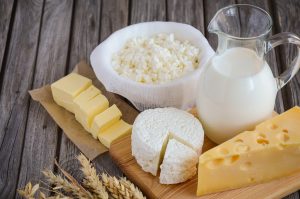
Top
The top absorbed those products, which must be reduced to a minimum. These include:
- animal fats;
- simple carbohydrates;
- sweets;
- baking from white flour;
- alcoholic products.
Do not also get involved in potatoes-it contains too much starch.

Each food group can be conditionally divided into portions. Determine the daily caloric value of your diet, based on sex, age and activity, to determine the number of servings and its size. Thus, when targeting groups, the portions of products can be expressed as follows:
- cereals – a slice of bread, 100 grams of cereal or pasta, 2-3 oatmeal cookies;
- vegetables – half a cup of raw or boiled vegetables, a glass of vegetable juice;
- fruit – one any medium fruit, a glass of fruit juice;
- proteins – 100 grams of meat, 3 eggs, three quarters of a plate of beans;
- dairy products – a glass of milk, a couple of slices of cheese, a third of a pack of cottage cheese;
- top – 2 tablespoons of sugar, 30 g of butter.
Variety of food pyramid
The food pyramid is based on five basic principles. The main of which is the rule of diversity, consisting in the fact that there is anything you can do, in the absence of allergies and contraindications. Each product group corresponds to its own color.
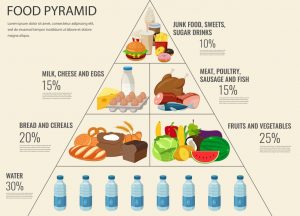
Orange
Includes all cereals: from bread to cereals. The group is rich in vitamins, minerals, dietary fiber, vegetable protein and poor in fat. Every day you need to eat six servings of cereals. In the scheme, orange takes the largest share, respectively, and in the diet of cereals should prevail. Preference in this case it is necessary to give bread with bran and oat.
Perhaps six portions sound like an unreal figure. But, given that one serving of the same cereal is 100 grams, a full plate for breakfast at 400 grams will already take four servings, plus a slice of bread and a couple of pieces of biscuits. That’s all six servings, as never happened.
Green
It is represented by all kinds of vegetables. Three to five servings per day will be enough. In this case, the diet should be made in such a way that it contains a portion of yellow, orange or green vegetables containing beta-carotene.
Red
Fruits, berries as well as vegetables – sources of beta-carotene, vitamin C, folic acid and other vitamins and microelements. They are also rich in plant fiber and organic acids. A day will require 2-3 servings of fruit, one of which must be citrus fruit.
You can drink and juice, but fresh fruit is still preferable, because it preserves vegetative fiber and contains less sugar. Both fruits and vegetables should be diverse. For example, if on Monday this is a banana, then on Tuesday an apple and so on.
Yellow
The narrowest strip, represented by fats. And vegetable fats are a priority. They even make up the base of the pyramid. The small width of the strip is associated with saturated fats, many of which are abused. So, you need to minimize oil and margarine, confectionery fat. Otherwise, you can earn problems with the cardiovascular system.
Blue
All dairy products, rich in vitamins, trace elements and are a source of high-grade animal proteins. They also contain lacto and bifidobacteria so necessary for our intestines. Every day you need to consume 2-3 servings of dairy products.
Purple
It is represented by plant and animal proteins. Also a day will need 2-3 servings. And one of them should consist of vegetable proteins, for example, nuts or beans, and two others – from animals – meat, fish, eggs. Meat is better to choose lean, and from sausages and sausages it is better to refuse altogether. Fish is also better to choose low-fat varieties.
Other principles of food pyramid and basic conditions for its maximum efficiency
In addition to the principle of diversity for the food pyramid, the following principles are also characteristic:
- Principle of proportionality. It consists in the fact that it is necessary to adhere to the correct ratio of food consumed in food. On the diagram this rule is reflected by different width of segments. For example, the yellow segment of fats is the narrowest, so in the diet, fats should occupy the very last place.
- Principle of individuality. Every person is different. And this includes not only his sex, age, body structure, but also food preferences. The food pyramid will help to make an individual healthy diet.
- The principle of moderation. The correct diet is not only in the quality of consumed foods, but also in their quantity. Moderate consumption means not overeating or starving.
- Principle of physical activity. This principle creates a parallel with the rest of the principles and is represented by the formula: a variety of food + physical activity = a beautiful and healthy body. This principle will be discussed in more detail a little later.
Do not take the food pyramid, as some rigid guide to nutrition. Of all the variety of products, everyone can make for themselves a suitable useful menu. And the maximum effect of the health pyramid will be given only if the following conditions are met:
- Maximum combination of products.
- Balancing eaten food with physical activity.
- Minimizing products from the top of the pyramid.
- Strict adherence to the choice of products from a particular group – there should not be a substitute.
- Consuming only fresh food, avoiding ready meals.
- A competent approach to the purchase of products with a study of their nutritional value and production date.
Types of food pyramids
In addition to the well-known pyramid, there are other varieties of it:
- Vegetarian. Another name is a pyramid of plant origin, i.e. It excludes all meat and dairy products, as well as eggs and fish. The basis of nutrition is based on cereals, legumes, vegetables and fruits. Dairy products, as well as meat in the pyramid are replaced by soy products.
- The Mediterranean. The basis of nutrition is taken from cereals and vegetables – fruits. The price is also olive oil. Fish and seafood are second. Meat in this pyramid is recommended to eat no more than once a week.
- Children’s pyramid. Its principle is the same as the usual pyramid. The difference from the adult pyramid lies in the number and width of the segments. So, the first place is occupied by dairy products – this is the basis for feeding children up to the age of three. Further, there are fruits and vegetables, which in terms of the thickness of the segment are not inferior to dairy products. Next in line is meat. Fish is allocated in a separate segment. Undoubtedly the basis of baby food should be and cereals, which are better served in the form of cereals. As in the adult menu, the narrowest strip presents oils and fats. The butter can simply fill the porridge or salad. Eggs are also isolated in a separate small segment. The segment has also sweets, for children that can be presented in the form of honey and dried fruits. Therefore, they can be consumed in small quantities daily.
- Asian. The priority here is vegetables, rice, soy products and green tea.
- Pyramid for pregnant women. You can build your pyramid during the gestation period, when the need for vitamins, protein and minerals increases. Adjust your diet is advisable with the filing of an observant doctor.
Principle of physical activity

One of the principles of the healthy food pyramid is the principle of physical activity. On the diagram he is represented in the form of a man climbing the stairs. And the essence of this principle is that you can achieve a beautiful body only by combining a healthy diet with physical activity. Dietitians advise to give the last at least an hour a day.
And, to make up the calories lost by physical activity, you need to know how many calories you need to consume. So, for physically active people, 2,800 kcal will be needed, and, for example, for retired people or people leading a sedentary lifestyle – only 1600 kcal. Proceeding from this, you need to build your diet using all the principles of the pyramid.
If we take into account intensively trained athletes, then they should build their diet based on the following values of daily calories:
- 2500-2800 kcal – for women;
- 2800-4300 kcal – for men.
Thus, the daily portioning here will be somewhat different. So, for example, for women, leading an active lifestyle, cereals will not need six servings per day, in all ten.
The pyramid of healthy nutrition has undergone many changes: some corrections, both qualitative and quantitative, have been made, additions have been made. The principles were also revised. More recently, the principle of physical activity has come out even in the first place, pushing the principle of diversity.
Is the pyramid important for weight loss?
Food pyramid can be successfully used and for weight loss. So, according to its principles, the menu of one day for the losing weight can look like this.
| Food intake | Approximate diet |
| Breakfast | Portion of oatmeal + banana + a glass of skim milk.For those who do not have enough, it is allowed to add such a sandwich: a slice of bread with bran, thinly smeared with honey. |
| Lunch | Two oranges or two apples. |
| Dinner | Lettuce leaves with a slice of stew or boiled chicken or turkey meat. |
| Afternoon snack | A glass of fruit juice or grapefruit. |
| Dinner | Portion of cottage cheese and a glass of yogurt.Dinner should be at least three hours before bedtime. |
Each day can be different in its own way. So, the meat is changed to fish, oatmeal for wheat sprouts, and an apple for a pear. The main thing is to observe the permissible amount of calories.
The importance of the pyramid for weight loss is laid down in its principles, the main thing is to be able to use them correctly. So,
- portioning can be used to evenly eat at different times and control calories;
- the exclusion of harmful products also has a beneficial effect on those who want to lose weight;
- an increased amount of fiber will help the intestines work like a clock, which is also important for burning fat;
- the principle of physical activity speaks for itself – its combination with control of the food ration can lead to the desired result.
What else is important to know?
The most important thing to know when using a food pyramid is the purpose of its use. As a rule, there can be three of them:
- maintaining the available weight;
- weight gain;
- losing weight.
Proceeding from the goal and you need to adjust the diet for you. A help in this is such a formula: weight x 30 = the required number of kcal. The value obtained is the number of calories that need to be consumed to maintain body weight unchanged.
To set the body weight to the obtained value, 500 kcal should be added. If the goal is to lose weight – you need to gradually reduce the final figure. So, if it turned out 1800 kcal per day, then you need to achieve the values in 1700, 1600 and so on.
Summing up
Food Pyramid – this is not an ideal food system, suitable absolutely for everyone. These are only generalized principles of proper nutrition, which can have invaluable influence on further development in the field of nutrition. So, applying the rules of the pyramid in practice, perhaps later you will be able to learn and separate food or some other kind of proper nutrition that is right for you. Those. food pyramid – this is one of the steps to further development.